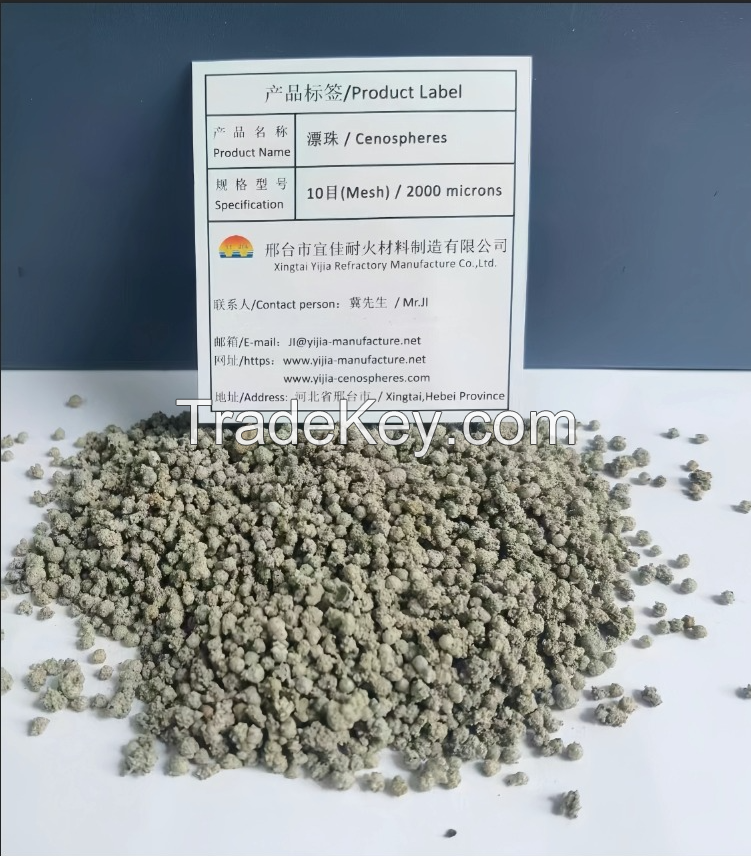Â
  Â
  Our
company has been engaged in the refractory materials industry for
many years, focusing on the in-depth research, development,
production, sales, and service of refractory materials.
Currently, we have established a complete set of management
models, production, and quality control systems. In recent years,
with the rapid development of the refractory materials industry,
the demand for quality and variety has been continuously
increasing.
  Â
 Cenospheres are grayish-white spherical in appearance and
possess multiple properties such as fine particles, light weight,
high strength, wear resistance, low thermal conductivity, high
refractoriness, thermal insulation, electrical insulation, and
uniform stress and strain. They are widely used as reinforcing
fillers in fields such as refractory and thermal insulation
materials, plastics, coatings, foundry, ceramics, and petroleum
drilling. They can not only effectively improve product
performance or construction results but also significantly reduce
production costs.
I.Cenosphere's
Chemical Composition:
|
Composition
|
SiOâ‚‚
|
Al₂O₃
|
Fe₂O₃
|
SO₃
|
|
Content(%)
|
****5
|
****6
|
0.**1.5
|
0.**0.2
|
Â
II.Physical
Properties of Fly Ash Beads:
|
Project
|
Test
Indicator
|
Project
|
Test
Indicator
|
|
shape
|
high-fluidity spherical
powder
|
Particle Size
(Mesh)
|
*****0 mesh
|
|
color
|
Light Grayish
White
|
Mohs
Hardness
|
**7
|
|
True
Density(g/ml)
|
0.**1.1
|
Melting
Point(℃)
|
≥***0
|
|
Bulk
Density(g/cm³)
|
0.***0.*6
|
Refractoriness(℃)
|
********0
|
Â
III.
Characteristics of Cenospheres:
1.High
refractoriness:The
main chemical components of cenospheres are oxides of silicon
and aluminum. Since the melting point of silicon dioxide is as
high as ***5 degrees Celsius, and the melting point of aluminum
trioxide is ***0 degrees Celsius, both are high refractory
substances. Therefore, cenospheres have extremely high
refractoriness.
2.Lightweight,
thermal insulation:Â Cenospheres
have thin walls and hollow interiors, with a semi-vacuum inside
the cavity, resulting in extremely slow and minimal heat
conduction. They are not only lightweight but also have
excellent thermal insulation
properties.
3.High
hardness and strength:Â Because
cenospheres are hard glass bodies formed by silicon-aluminum
oxide mineral phases (quartz and mullite), their hardness can
reach Mohs **7, and their static pressure strength is as high
as *****0MPa, thus having high
strength.
4.Insulating
and non-conductive:Â The
resistance of general insulators decreases with the increase of
temperature, but high-strength cenospheres are the opposite,
with resistance increasing as temperature rises. This advantage
is not possessed by other insulating materials. Therefore, it
can be made into insulating materials with excellent
performance.
5.Fine
particle size and large specific surface
area:The
naturally formed particle size of high-strength cenospheres is
*****5 microns. The specific surface area is ******0
g/cm², which is
equivalent to that of cement. It can be used directly without
grinding. The fineness can meet the needs of various
products.
Â
IV. Uses
of Cenospheres:
1.Refractory
and thermal insulation
materials:Â Such
as lightweight sintered refractory bricks, lightweight
non-fired refractory bricks, casting insulation risers,
pipeline insulation shells, fireproof and thermal insulation
coatings, thermal insulation pastes, composite thermal
insulation dry powders, lightweight thermal insulation and
wear-resistant glass fiber reinforced
plastics.
2.Building
materials:Â Building
decoration, high-grade pavement materials, roof waterproof and
thermal insulation coatings, modified asphalt,
etc.
3.Petroleum
industry:Â Oilfield
cementing, pipeline anti-corrosion and insulation, offshore
oilfields, floating devices, oil well drilling mud lightening
agents, oil and gas transmission pipelines,
etc.
4.Insulating
materials; Plastic activated fillers, high-temperature and
high-pressure insulators, etc.
5.Coating
industry:Â Paints,
inks, adhesives, stealth coatings, insulating paints,
anti-corrosion paints, floor paints, high-temperature resistant
and fireproof paints, interior and exterior wall coatings,
thermal insulation coatings, floor paints, automotive putties,
atomic ash, etc.
6.Plastic
industry:Â Such
as automotive trim parts, instrument panels, home appliance
casings, fans, speakers, lamp assemblies, plates,
etc.
7.Glass
fiber reinforced plastic products: Various glass fiber
reinforced plastic products, artificial marble, glass fiber
reinforced plastic ships, handicrafts,
etc.
8.Encapsulation
materials: Transformer potting materials, electronic
encapsulation materials, etc.


